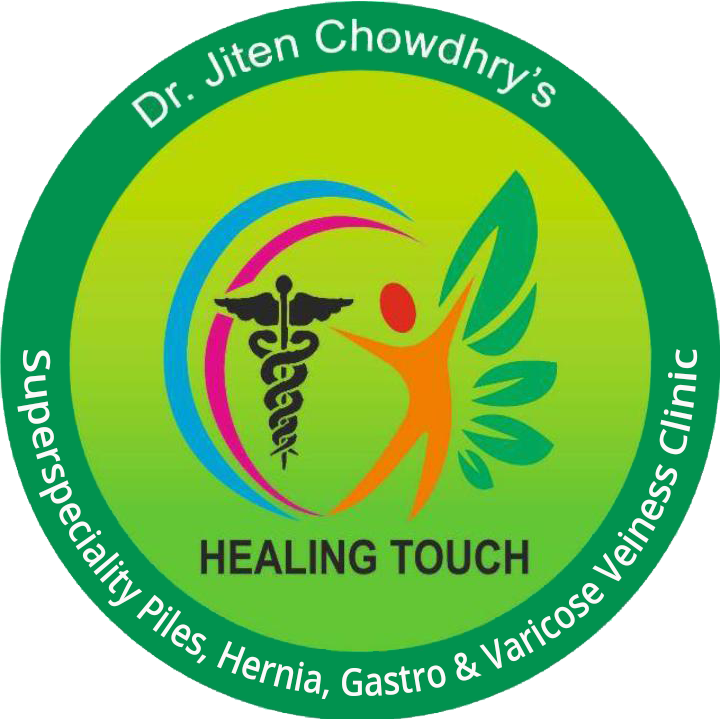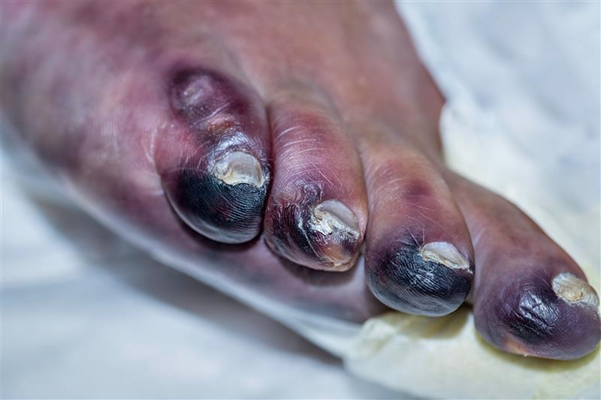Gangrene is a serious condition where body tissue dies. It happens when blood flow to that area is blocked. This makes it crucial to catch signs early. Otherwise, you might face some scary outcomes. By knowing gangrene symptoms, you can act fast. Learning about these gangrene symptoms makes you more informed. This way, you’ll know when to see a doctor. Let’s get a grip on what gangrene is and why it matters.
Introduction: Understanding Gangrene’s Impact
Understanding gangrene isn’t as hard as it feels. At its simplest, gangrene is when tissues in the body die off. Blood isn’t able to reach them, and that’s how problems start. You’ll come across three different kinds of this condition: dry, wet, and gas gangrene.
- Dry Gangrene:
- This type arises when blood simply can’t flow to a certain area.
- Often, this happens in the limbs, such as your toes or fingers.
- Wet Gangrene:
- Moist areas lead to bacteria growth, causing wounds to ooze with pus.
- The condition spreads quickly and can lead to infections.
- Gas Gangrene:
- This happens when certain bacteria invade a wound.
- It causes painful swelling and emits a nasty smell.
Now, what brings this about? The culprits are infections, lack of blood flow, or injuries that go untreated. Identifying types gives clarity on handling them. It equips you with needed knowledge to identify how to identify gangrene.
Comprehending Gangrene: A Disease Insight
Recognizing gangrene symptoms overview involves watching for skin changes.
- Skin Alterations:
- Watch out for skin that darkens or pales.
- Areas might turn blue, purple, or black.
- Feeling in Limbs:
- You may feel sudden pain, or your fingers and toes might go numb.
- Whether it’s pain or numbness, both are cause for concern.
- Swelling and Sores:
- Don’t ignore parts that swell up without clear reason.
- If you see strange fluid leaking, it’s time to worry. Paying attention to these signs gets you ahead in managing the problem. An early call to action could prevent things from getting serious.
Gangrene: General Symptoms Illustration
Differentiating between dry vs wet gangrene symptoms is key to responding quickly.
- Dry Gangrene:
- Often hits fingers and toes, and looks ashen.
- Slowly, it turns into a deep shade, like black.
- No infection, but tissues shrivel and shrink.
- Wet Gangrene:
- Stems from wounds that fester, turning severely red.
- It spreads more than the uninformed might think.
- With pus forming and a putrid smell, it’s nasty.
- Lingering Sores:
- Constant open sores won’t heal and are dangerous.
- It’s wise to speak to someone for a medical view. Comparing these signs helps you spot differences quickly. You become better aware of what to expect and how to respond.
Recognizing Dry Vs. Wet Gangrene
Gas gangrene is fierce and requires fast awareness.
- Pain and Numbness:
- Keep aware of any sharp pain followed by numbness.
- This indicates an issue that needs prompt care.
- Color and Swelling:
- Discoloration marks the skin, turning it deeply purple.
- Swelling occurs fast, accompanied by a foul odor.
- Link to Past Injuries:
- Often appears in areas that had a wound.
- Check if old injuries start acting up strangely. When observing symptoms of gas gangrene, urgency trumps all. Fast action can turn things around before it gets worse. Know when wounds require medical attention to prevent severe outcomes.
Spotting Symptoms of Gas Gangrene
Differentiating infection from something dire like gangrene infection indicators is vital.
- Signs of Infection:
- Keep an eye out for signs of skin feeling hot.
- Fevers, chills, and a racing heartbeat signal infection.
- Beware of feeling nauseous or vomiting.
- Understanding Septic Shock:
- Look for difficulty in breathing, confusion, or drowsiness.
- Untreated infections cause severe drops in blood pressure.
- Address these urgently to avoid further complications. Recognizing when symptoms escalate amounts to body’s saving grace. Remaining vigilant in spotting these indicators helps in timely medical intervention.
Infections and Indicators of Septic Shock
In India, culture and lifestyle play roles in exposure to gangrene symptoms overview.
- Regional Factors:
- Traditional practices pose infection risks.
- Lack of hygiene awareness cultivates concern.
- High-Risk Populations:
- Diabetes patients face higher odds due to poor blood circulation.
- Those with artery issues must stay wary.
- Awareness and Self-Assessment:
- Regular checkups aid in early detection, catching issues early.
- Self-awareness empowers proactive healthcare actions. By taking cultural habits into account, one navigates gangrene risks better. Acknowledging factors aids in taking steps toward prevention and awareness.
Cultural and Risk Factors Unique to India
Responding to gangrene symptoms is vital for minimizing harm.
- Early Diagnosis:
- Rapid intervention can save affected areas.
- Healthy tissue might be saved with timely treatment.
- Problems of Delay:
- Waiting often results in spreading, heightening risks.
- Severe cases lead to loss of limbs or worse outcomes. Timely reaction to signs is an immense healthcare tool. Knowledge ensures fast medical response, with consequences being avoided.
Importance of Targeted Awareness and Early Reaction
Real experiences underscore the value of recognizing trouble early.
- Patient Accounts:
- Ramesh’s swift visit led to early treatment and recovery.
- Meena caught gangrene symptoms early, saving her foot.
- Impact of Early Detection:
- Early actions led to lessened gangrene spread.
- Interventions resulted in improved quality of life. Success greatly stems from recognizing issues in time. Stories from patients show the significance of early awareness.
Real-Life Stories: Early Recognition Saves Lives
Taking quick action cuts down gangrene symptoms overview severity.
- Reaching Out Swiftly:
- Contact healthcare when unsure about symptoms.
- They can provide appropriate guidance and options.
- Recognizing Emergency Cases:
- If septic shock is a risk, don’t delay immediate care.
- These situations have a critical impact on health. Being proactive is the ace you hold. Quick calls to a doctor upon noticing suspect signs make all the difference.
Effective Modern Medical Approaches
In today’s world, medical science keeps growing with new ideas. Doctors use modern ways to treat early-stage gangrene problems. Starting treatment early can help save body parts at risk. First, removing dead tissue is very important during treatment. After this, special bandages and suction help wounds heal faster. Breathing pure oxygen in a special chamber can also aid healing here. Medicine to fight infection is key if germs are present. These methods help stop the problem from getting worse and improve lives. If surgery is needed, it is more careful now and helps patients lead better lives.
Learning new things about handling gangrene is very important today. Researchers work on better tools to spot gangrene early on in patients. Quick detection lets doctors plan more effective treatments for each person. New tools like heat mapping and nice images help doctors decide sooner. There’s real focus on personal care plans that suit each patient’s needs. Scientists work tirelessly to create exact treatments that lower big risks for patients.
Deciphering Gangrene on Diverse Skin Tones
Recognizing signs of gangrene on darker skin can sometimes be tricky. It poses challenges since discoloration and textural changes are less obvious. Doctors stress careful checks and knowing personal skin history is crucial. Understanding typical skin tone is key to spotting any changes. Pay attention to symptoms like pain or swelling, which might indicate gangrene. Knowing how to identify gangrene needs sharp eyes and proper tools.
Skin type affects how gangrene shows up in different ways. For example, lighter skin may show more red, while darker skin might appear dull or shiny. Some skins are more likely to have weird textures or feel different if gangrene is present. Wet and dry gangrene symptoms may look different across various skin tones. It’s important for doctors and patients to know these differences for better care that suits everyone.
Proactive Measures Against Gangrene Development
Keeping cuts and blisters clean is very important after an injury. You should always wash wounds and look for infections quickly each time. It will help to talk with doctors if you see odd signs. It keeps everything healing as it should, reducing bad problems.
Diabetes can make someone more likely to get gangrene. Keeping a watch on sugar levels helps reduce this risk often. It’s wise to visit your doctor regularly and watch your health closely. Simple changes like better food habits and exercise really help you stay healthy.
Health Focus: Circulation and Foot Care Importance
Foot care is vital for keeping gangrene at bay. Proper shoes keep feet safe from harm. Good circulation gets blood flowing to help feet heal. Check your feet daily to spot any issues early on. Simple exercises like walking or stretching help maintain healthy circulation. This practice lowers the risk of foot troubles down the road.
People with diabetes need to pay special attention to foot care. They should wear shoes that fit well and give good support. Doing a daily foot check helps catch problems early on. Regular visits to a podiatrist ensure your feet stay healthy. Keeping your feet moisturized prevents dryness and cracking in skin. Gentle exercises help boost circulation, which is crucial for those with diabetes.
Conclusion: Empowerment Through Vigilance
Understanding gangrene symptoms is key for effective prevention and care. It’s important to notice signs like discolored skin or strange pain early. If you recognize these symptoms, seek medical help fast before it gets worse.
Getting medical help quickly is very important when you notice odd changes. Don’t wait if you feel numbness or see something unusual. Going to the doctor quickly can stop small issues from becoming big problems later on.
Knowing about your health conditions can make you take better steps for prevention. Learning and understanding gangrene encourages regular self-checkups. This knowledge improves patient and doctor communication, promoting a healthier lifestyle.
Resources and Support Networks
Patients are encouraged to explore a variety of resources nearby. Reliable medical websites and healthcare apps offer detailed information about gangrene symptoms overview. These platforms can enhance understanding, offering helpful knowledge.
Access to local healthcare contacts could be pivotal during emergencies. It is vital to know whom to call and where to go to quickly address any issues. Connecting with local healthcare networks provides timely help when needed.
Special Call to Action: Jiten Chowdhry
By boosting awareness in the community, Jiten Chowdhry speaks to all of us. Gangrene is a serious health issue that prompts necessary conversations.
When people share insights on gangrene symptoms overview, connections grow stronger. This understanding allows us to watch out for these symptoms closely. We stand together, promoting watchfulness and necessary health measures.


